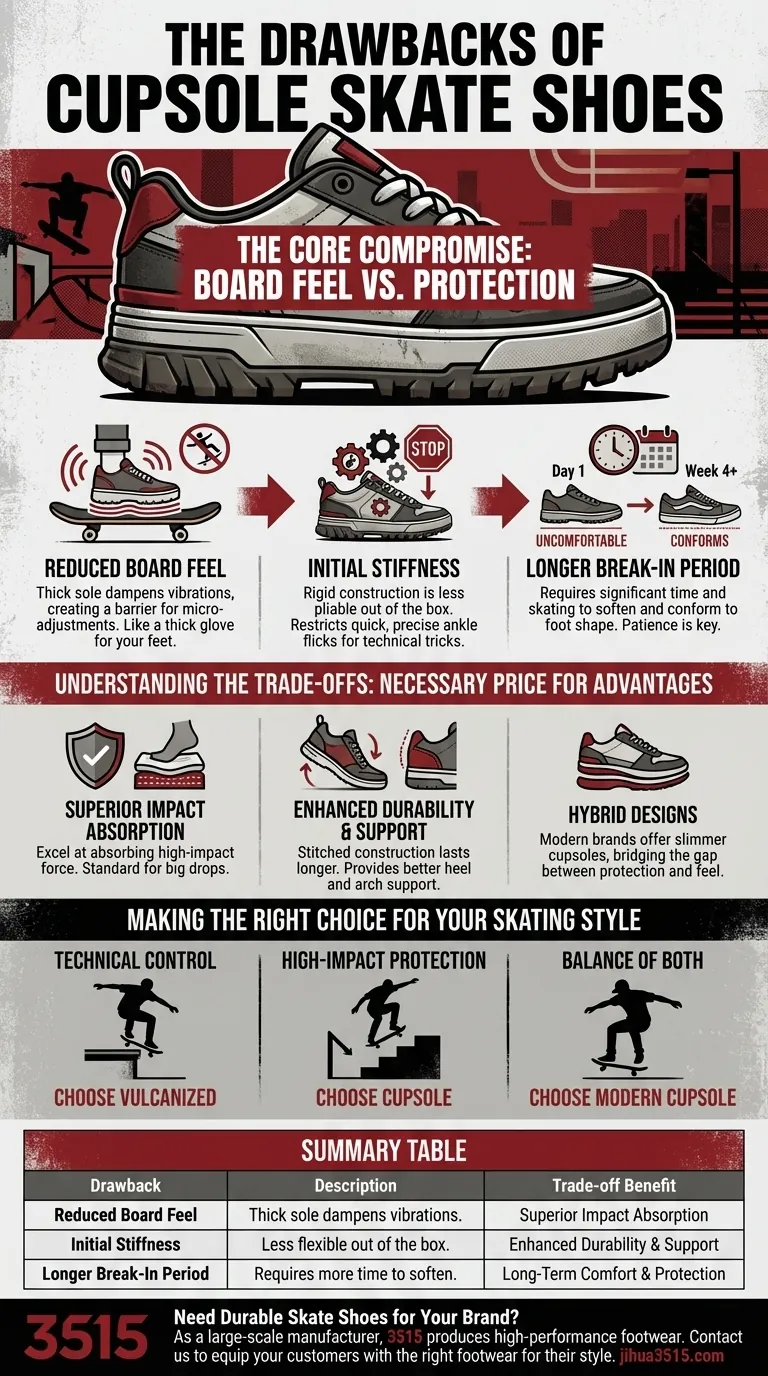The primary drawbacks of a cupsole skate shoe are its inherent stiffness, reduced board feel, and a significantly longer break-in period compared to its vulcanized counterpart. This is a direct result of its thicker, more durable construction, which is designed for impact absorption rather than direct board-to-foot feedback.
The choice between shoe constructions is not about finding a "better" option, but about understanding a fundamental trade-off. Cupsoles sacrifice the immediate flexibility and intimate board feel of vulcanized shoes to deliver superior impact protection, support, and long-term durability.

The Core Compromise: Board Feel vs. Protection
The design of a cupsole is fundamentally different from a vulcanized shoe, and this construction dictates its performance characteristics. Understanding this difference is key to seeing why the drawbacks exist.
Reduced Board Feel Explained
A cupsole features a thick, pre-molded rubber sole that is stitched or glued to the upper. This creates a more substantial barrier between your foot and the skateboard.
This thickness, often enhanced with a foam midsole, dampens the subtle vibrations and contours of the board, reducing your ability to make micro-adjustments. It’s akin to trying to feel a texture while wearing a thick glove.
The Problem with Less Flexibility
The rigid, one-piece nature of a cupsole makes the shoe less pliable out of the box. This stiffness can initially feel restrictive.
For technical tricks that rely on a quick, precise flick from the ankle, this lack of flexibility can be a hindrance until the shoe has been thoroughly worn in.
The Extended Break-In Period
The direct result of this stiff, durable construction is a longer break-in period. Where a vulcanized shoe feels nearly perfect on day one, a cupsole requires time and consistent skating to soften and conform to your foot's shape.
Understanding the Trade-offs
While the drawbacks are clear, they are the necessary price for a cupsole's primary advantages. No shoe can maximize both board feel and impact protection simultaneously.
Superior Impact Absorption
The very thickness that hinders board feel is what protects your feet. Cupsoles excel at absorbing the force from high-impact skating.
This construction allows for features like EVA foam midsoles, providing cushioning that is simply not possible in a thin vulcanized shoe. This makes them the standard for skaters jumping down large stair sets or gaps.
Enhanced Durability and Support
The stitched cupsole construction is inherently more durable than a vulcanized sole, which is essentially baked onto the upper. This means they last longer under aggressive skating conditions.
They also provide significantly more heel and arch support, which can help prevent foot fatigue and injuries like bruised heels.
The Rise of Hybrid Designs
It's important to note that shoe technology is not static. Many modern brands offer thinner, more flexible cupsole models designed to bridge the gap, providing more protection than a vulcanized shoe with better board feel than a traditional, bulky cupsole.
Making the Right Choice for Your Skating Style
Ultimately, the "drawbacks" of a cupsole are only drawbacks if they don't align with your needs. Your decision should be based entirely on your primary style of skating.
- If your primary focus is technical control and board feel: For flatground, ledge, or manual skating, the stiffness of a cupsole is a clear disadvantage and a vulcanized shoe is likely the better choice.
- If your primary focus is high-impact protection and durability: For skating stairs, gaps, or simply wanting a shoe that lasts longer and supports your foot, the benefits of a cupsole far outweigh its initial drawbacks.
- If your primary focus is a balance of both: Seek out modern, slimmer cupsole models that are specifically engineered to offer a middle ground between protection and board feel.
Understanding this core trade-off empowers you to choose the right tool for your specific goals on the board.
Summary Table:
| Drawback | Description | Trade-off Benefit |
|---|---|---|
| Reduced Board Feel | Thick sole dampens vibrations from the board. | Superior Impact Absorption |
| Initial Stiffness | Less flexible out of the box, restricting ankle movement. | Enhanced Durability & Support |
| Longer Break-In Period | Requires more time to soften and conform to your foot. | Long-Term Comfort & Protection |
Need Durable Skate Shoes for Your Brand or Store?
As a large-scale manufacturer, 3515 produces a comprehensive range of high-performance footwear for distributors, brand owners, and bulk clients. Our production capabilities encompass all types of durable skate shoes and boots, including advanced cupsole designs that balance protection and board feel.
Let us help you equip your customers with the right footwear for their style.
Contact our team today to discuss your manufacturing needs and get a quote!
Visual Guide

Related Products
- Wholesale Breathable Training Shoes Custom Athletic Footwear Manufacturer
- Lightweight Breathable Training Shoes for Wholesale & Custom OEM Manufacturing
- Premium KPU Athletic Safety Shoes for Wholesale
- Wholesale Breathable & Cushioned Training Shoes Custom Factory Production
- Wholesale Durable & Breathable Training Shoes for Custom Brands
People Also Ask
- How do non-slip athletic shoes differ from regular athletic shoes? Discover the Grip Technology
- What are the benefits of breathable mesh in shoe design? Enhance Comfort and Performance
- How do athletic shoes with non-slip features differ from regular ones? Discover the Grip Advantage
- What are the characteristics of canvas as a shoe material? A Guide to Lightweight, Breathable Footwear
- What should be considered when choosing smart trainers for business casual? A Guide to Professional Style



















